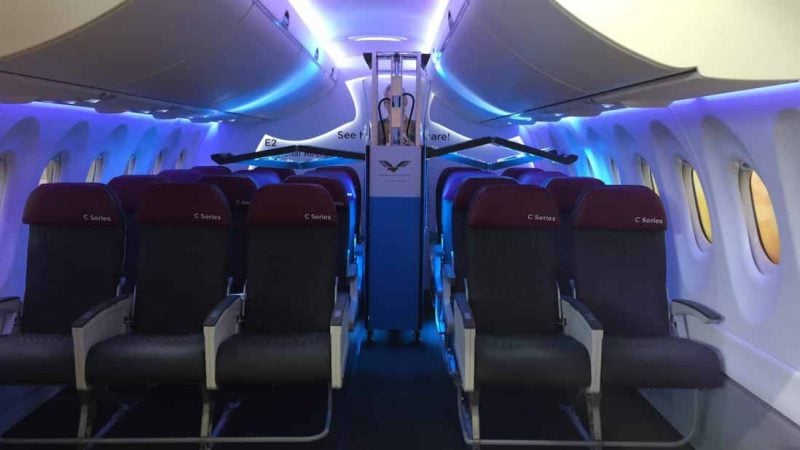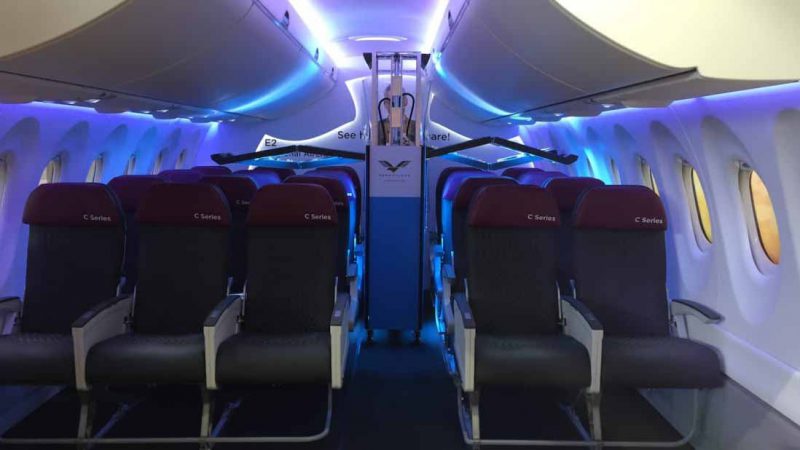Seeking a Coronavirus Killer? Look Up
New technology for disinfecting airplanes and public spaces may be as old as the universe itself
March 23, 2020


As the world goes on pause with rising numbers in COVID-19 cases, creative concepts in vanquishing the coronavirus are also on the rise. Some of these practices should probably stay in Grandma’s medicine chest, while others are gaining credibility and second looks by lab rats, members of the medical community, and manufacturing moguls looking to make a profitable pivot.
Standing out from the fray of Nettie pots, thermal scanners, avoidance of Chinese foods and products, bemoaning the presence of bats, gargling with warm water and imbibing concentrated quantities of orange juice … is the lonely UV light.
Ultraviolet light has been around since the beginning of the universe. It’s electromagnetic radiation with wave lengths shorter than visible light all around us through sunlight. Discovered by German physicist Johann Wilhelm Ritter in 1801, it is widely used in common products and truly caught on as a household phenomenon during the 1960s psychedelic era as the purplish light that led to special visual effects in wall décor.
As the coronavirus proliferates through the physical landscapes and zeitgeists of our communities, the mighty UV light could be readying for its come-back as a virus killer that needs no special kits and no medical permissions.
Recently, Boeing announced it was using new UV technology as an efficient way to clean bathroom surfaces on its aircraft. The self-cleaning lavatory concept debuted in 2016 and was a hit in its design along with touchless faucets for a more hygienic, less worrisome experience that had a 99.99 percent kill rate for pathogens. Now the aircraft manufacturing company is creating a “next-generation polymer coating that can be applied to armrests, tray tables and other surfaces to help prevent the spread of viruses within the cabin.”
The UV light destroys all known microbes by literally making them explode. The added polymer works by killing viruses and bacteria quickly through disrupting the microbe’s outer shell and dehydrating the area around the microbe. “We believe that using the far UV is the key to making those surfaces cleaner,” said Teresa King, Boeing principal investigator in product development. “We position the lights throughout the lavatory so that it floods the touch surfaces like the toilet seat, sink, countertops, etc. with the UV light. This sanitizing even eliminates odors from bacteria so that passengers can have a more pleasant experience.”
Taking this technology to the next level is Dimer, a Los Angeles-based company that is creating GermFalcon, a germ-killing robot that can sanitize airplanes. The system uses ultraviolet-C (UVC) light to kill viruses, bacteria, and superbugs on surfaces and in the surrounding air. Designed to easily navigate an airplane cabin, GermFalcon’s strategically placed UVC lamps expose all high-touch surfaces to germicidal UVC light. UVC is different that UV-A and UV-B that one experiences in tanning salons or from sunbathing. The C is the germ-killing wavelength.
UVC light is commonly used for disinfection of air, water, and surfaces in healthcare facilities. It has been proven safe and highly effective in eliminating germs that cause infectious diseases, including coronavirus, influenza, and Ebola. The GermFalcon is the first UVC system designed to quickly disinfect an aircraft’s interior surfaces between flights.
“The threat of coronavirus infecting innocent passengers on an airplane is one we must work to eliminate immediately,” said Dimer Co-Founder Elliot Kreitenberg. “This is a dangerous virus that has already taken lives. GermFalcon is a fast and effective response to this threat, and we are pleased to offer it at no expense to contribute to emergency response efforts at LAX, SFO, and JFK airports during this crisis.”
The current prototype offered to airlines works more or less like a beverage cart with long wings that extend over each row of seats, bathing them in the light. Initial trials are promising, but the company has not had the benefit of professional trials with use by an aircraft.
“It is possible to inactivate viruses using UV light in laboratory settings,” Akiko Iwasaki, a professor of immunology at the Yale University School of Medicine, told the New York Times. According Alex Berezow, a microbiologist who has published articles on the topic, “UV light is lethal to bacteria and viruses because of its high frequency that scrambles and damages their nuclear material. When it damages the DNA (or RNA) code of these pathogens, it also triggers lethal mutations that prevent them from reproducing properly. UV light kills everything: bacteria, fungi, viruses. It should kill coronavirus.”
Hospitals and laboratories often use ultraviolet (UV) light to kill microbes and Delta Air Lines recently entered into an agreement with Vital Vio, a Troy, New York-based company that designs LED lights meant to continuously squelch bacteria on its airplanes. The lights have been primarily marketed to hospitals, gyms and hotel operators.
UV lights are not recommended for use on humans or as a background light in places people stay or sit for long periods of time. The absorbed light waves can harm the skin, cause premature aging and even lead to cancer. A recent emergence of UV wands as a personal prophylactic tool against this virus have been showing up in programmatically fed Internet ads. So far the wands have been deemed safe to use, although not necessarily completely effective and the item has not been tested widely enough on varied surfaces, nor yielded professionally published results.
“I would say that UV-light wands may be useful as an alternative to chemical cleaners on tabletops or other ‘plain’ surfaces,” said Berezow.




